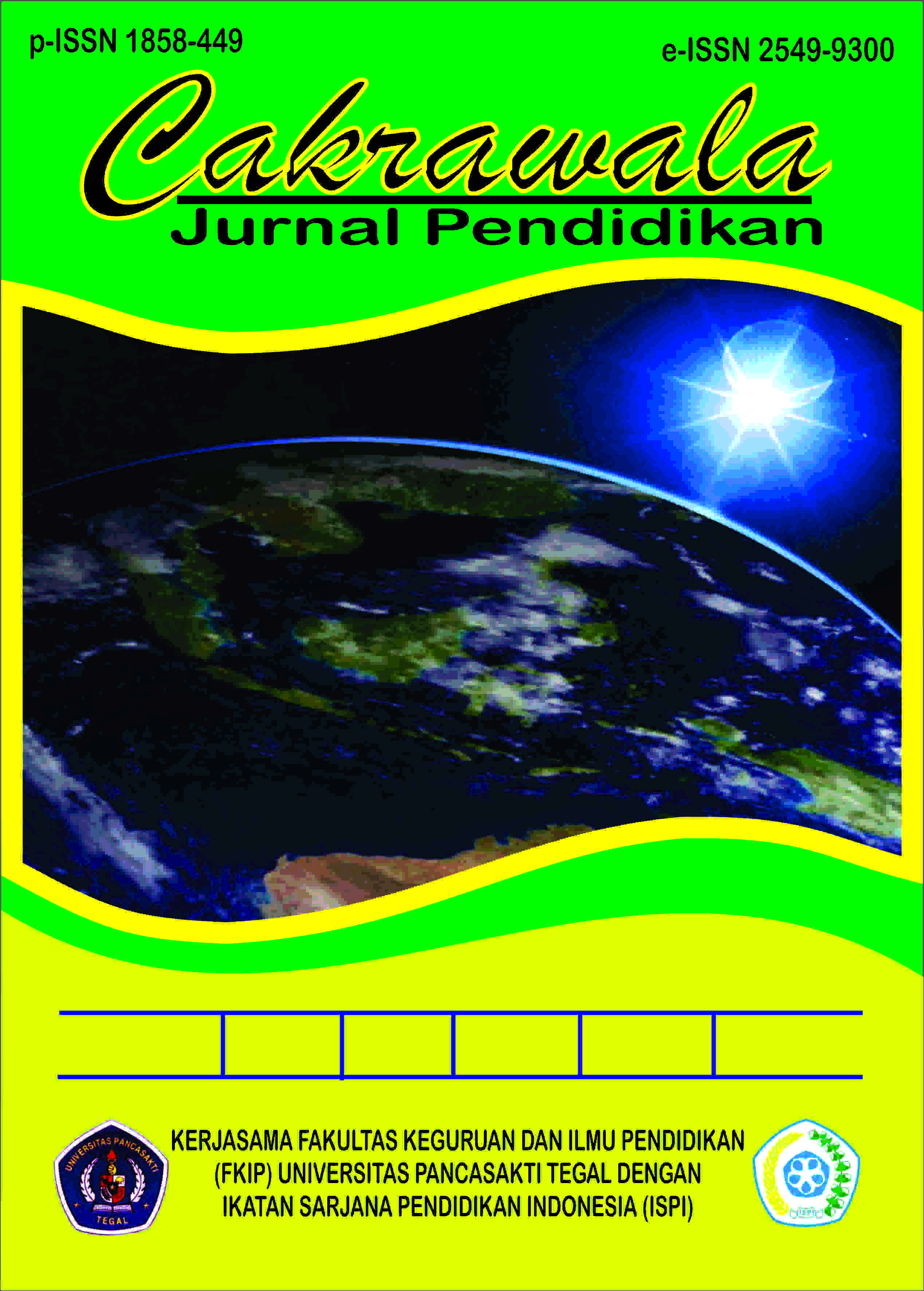The Effectiveness of Brain Mapping Method In Students’ Reading Comprehension by Using Blogger Based in Merdeka Curriculum
Main Article Content
Abstract
Most of the students got low scores in reading and understanding the material in online classes, this situation should be attention to Merdeka Curriculum. Most of the students lack interest in learning reading in an online class, because the learning methods in reading did not attract students, so the students had difficulty in answering explicit and implicit questions in reading comprehension. The purpose of this research is to determine the significant differences before and after using the brain mapping method in students' reading comprehension. This research designed as quantitative research that used one group pre-test and post-test design. sample amounted to 35 students. Collecting data used documentation and reading comprehension tests which were analyzed using Paired T-test with the help of SPSS 18 for Windows and N-Gain using Microsoft Excel. The post-test average learning outcome (77,29) was greater than the pretest (69.00). The results of the paired t-test showed the significance value (2-tailed) was 0.000 means there was significant effectiveness before and after using the Brain Mapping method toward Blogger as the online media for learning reading. The results of N-Gain showed the students’ learning outcomes improved from 35 students, 21 (60%) students got improvement in the medium category and 14 (40%) students got improvement in the low category. Brain mapping method combined with rewards and interesting materials can improve student achievement where students are more active and enthusiastic in the online teaching and learning process.,
Article Details

This work is licensed under a Creative Commons Attribution-NonCommercial 4.0 International License.
With the receipt of the article by the Editorial Board of the Cakrawala: Jurnal Ilmu Pendidikan and it was decided to be published, then the copyright regarding the article will be diverted to Cakrawala: Jurnal Ilmu Pendidikan.
Cakrawala: Jurnal Ilmu Pendidikan hold the copyright regarding all the published articles and has the right to multiply and distribute the article under Creative Commons Attribution-NonCommercial 4.0 International License.
A copyright transfer from the author to the journal is done by filling out the copyright transfer form by the author.
Copyright Transfer Letter: Download
Creative Commons Attribution-NonCommercial 4.0 International License
References
Chawinga, W. D. (2017). Taking social media to a university classroom: teaching and learning using Twitter and blogs. International Journal of Educational Technology in Higher Education, 14(1), 3. https://doi.org/10.1186/s41239-017-0041-6
Cheuk-Hung Chan, J., Yun Chen, J., Shiu-Ming Lai, J., Zuo, L., Dillman, D., & Miller Juvé, A. (2020). Learning at home during COVID-19: A multi-institutional virtual learning collaboration. Medical Education, 54(7), 664–665. https://doi.org/10.1111/MEDU.14194
Garcia, E., Elbeltagi, I., Brown, M., & Dungay, K. (2015). The implications of a connectivist learning blog model and the changing role of teaching and learning. British Journal of Educational Technology, 46(4), 877–894. https://doi.org/10.1111/BJET.12184
Garcia, E., Moizer, J., Wilkins, S., & Haddoud, M. Y. (2019). Student learning in higher education through blogging in the classroom. Computers & Education, 136, 61–74. https://doi.org/10.1016/J.COMPEDU.2019.03.011
Houlden, S., & Veletsianos, G. (2021). The problem with flexible learning: neoliberalism, freedom, and learner subjectivities. Learning, Media and Technology, 46(2), 144–155. https://doi.org/10.1080/17439884.2020.1833920
Ifinedo, P. (2017). Examining students’ intention to continue using blogs for learning: Perspectives from technology acceptance, motivational, and social-cognitive frameworks. Computers in Human Behavior, 72, 189–199. https://doi.org/10.1016/J.CHB.2016.12.049
Ilyas, I. (2020). Teknologi Pembelajaran Sebagai Media Pembelajaran. Cendikia Publisher. https://books.google.co.id/books?hl=id&lr=&id=lPcOEAAAQBAJ&oi=fnd&pg=PA25&dq=teknologi+pembelajaran&ots=ByqRSjwoih&sig=_IHtKWU2H8ngvdRHobixkxftBuk&redir_esc=y#v=onepage&q=teknologi pembelajaran&f=false
Kocisky, T., Schwarz, J., Blunsom, P., Dyer, C., Hermann, K. M., Melis, G., & Grefenstette, E. (2018). The NarrativeQA Reading Comprehension Challenge. Transactions of the Association for Computational Linguistics, 6, 317–328. https://doi.org/10.1162/tacl_a_00023
Lee, J., & Bonk, C. J. (2016). Social network analysis of peer relationships and online interactions in a blended class using blogs. The Internet and Higher Education, 28, 35–44. https://doi.org/10.1016/J.IHEDUC.2015.09.001
Martin, F., Stamper, B., & Flowers, C. (2020). Examining student perception of readiness for online learning: Importance and confidence. Online Learning Journal, 24(2), 38–58. https://doi.org/10.24059/olj.v24i2.2053
Nur Saputra, D. (2021). Learning Innovation Through Freedom Learning Management in Music Education Program. Education, Sustainability & Society, 4(2), 43–49. https://doi.org/10.26480/ess.02.2021.43.49
Oakhill, J., Cain, K., & Elbro, C. (2019). Reading comprehension and reading comprehension difficulties. Reading Development and Difficulties: Bridging the Gap Between Research and Practice, 83–115. https://doi.org/10.1007/978-3-030-26550-2_5/COVER
Pilkington, O. A. (2018). Active Learning for an Online Composition Classroom: Blogging As an Enhancement of Online Curriculum. Journal of Educational Technology Systems, 47(2), 213–226. https://doi.org/10.1177/0047239518788278
Rosiana, C., & Cahyanti, T. W. (2022). The Effectiveness Smart Chart to Improve the Students Understanding in Linguistic. IECA: Internatinal Journal of Education and Curriculum Aplicatin, 5(2), 87–94.
Sastry, C. C., Hariharan, P., & Pradeep Kumar, M. (2019). Experimental investigation of dry, wet and cryogenic boring of AA 7075 alloy. Materials and MAanufacturing Process, 34(7), 814–831. https://doi.org/10.1080/10426914.2019.1605174
Truong, M. T., & Murray, J. (2019). Understanding language teacher motivation in online professional development: A study of Vietnamese EFL teachers. Tesl-Ej, 23(3), 1–22.
Vu Anh, T. L., & Le Quoc, T. (2019). Development orientation for higher education training programme of mechanical engineering in industrial revolution 4.0: A perspective in Vietnam. Journal of Mechanical Engineering Research and Developments, 42(1), 71–73. https://doi.org/10.26480/jmerd.01.2019.71.73

